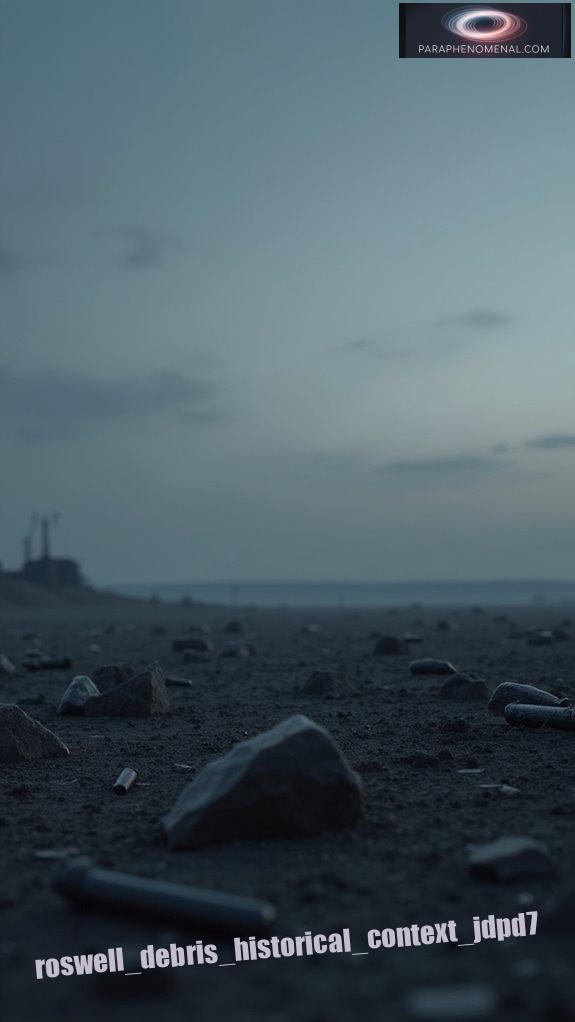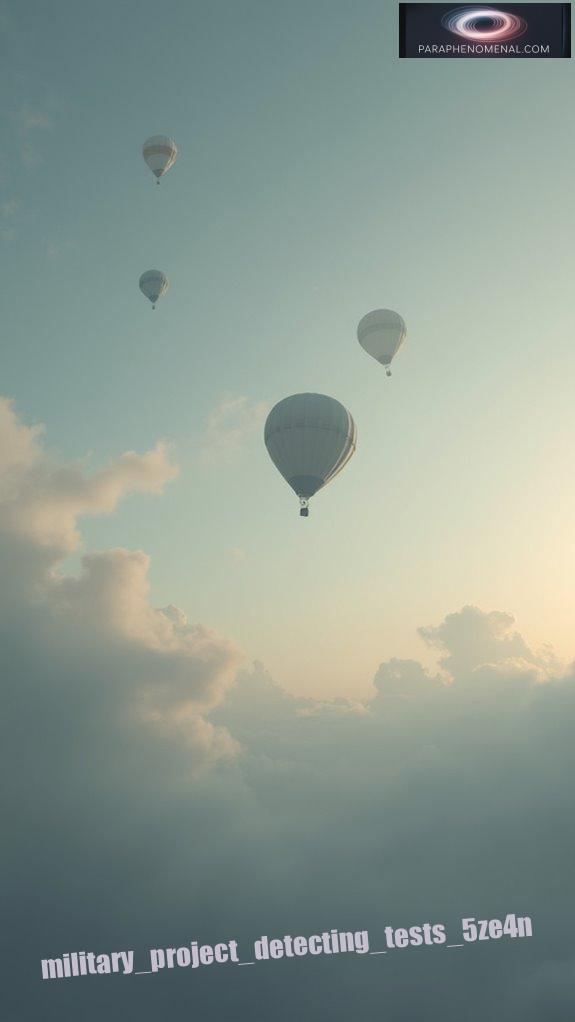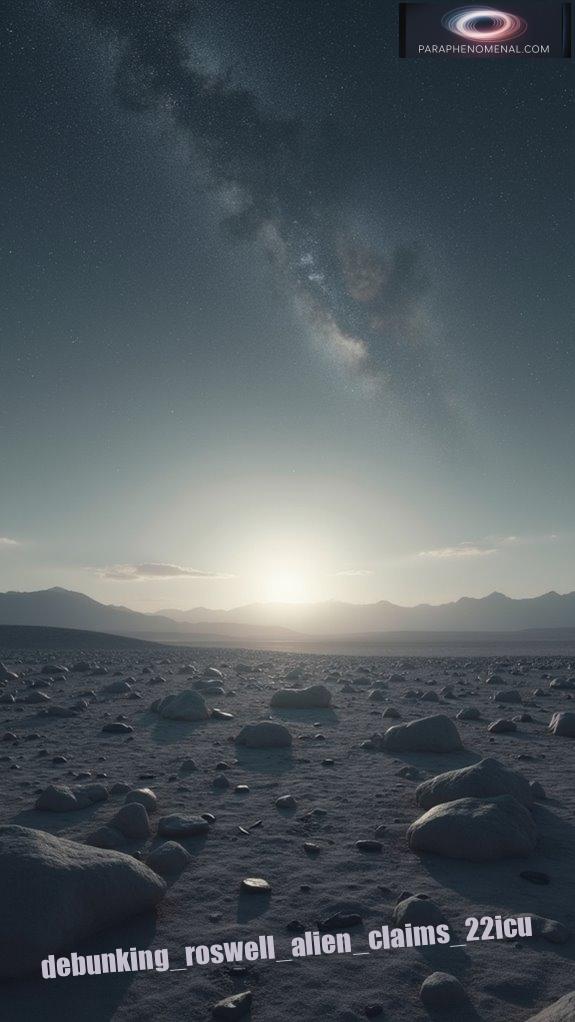Curious about the enigmatic Roswell metallic debris?
I certainly was, and here’s how I tackled the mystery.
First, I dove deep into material composition. Using tools like X-ray Diffraction and Scanning Electron Microscopy, I uncovered elemental signatures that hinted at advanced engineering.
Then, I pieced together the puzzle with historical documents and eyewitness accounts from 1947. This approach provided a clearer picture of the debris’s origins.
Could there be more than meets the eye? The search for answers is endlessly fascinating.
Real-life Encounter with the Roswell Mystery
During my research on UFO phenomena, I attended a convention where a former military officer shared his account of the Roswell incident.
He described firsthand experiences and his attempts to debunk the myths surrounding the debris. Listening to real-life stories sparked deeper interest in not only Roswell but other unexplained sightings as well.
Could such phenomena really be tied to advanced technology? This experience underscored how human narratives and historical contexts shape our understanding of the UFO phenomenon, opening doors to other unexplained mysteries from history.
Quick Takeaways
- Conduct thorough elemental and isotopic analysis to determine the composition and origins of the metallic debris.
- Utilize advanced microscopy techniques like SEM and XRD to examine surface structures and crystal formations for engineering insights.
- Integrate historical documentation and eyewitness accounts to contextualize findings and prevent misinterpretation of materials.
- Employ non-destructive testing methods to maintain the integrity of samples during analysis, ensuring reliable results.
- Coordinate physical findings with historical context to validate claims of terrestrial origins and support comprehensive conclusions.
Conduct Comprehensive Material Composition Analysis

A thorough material composition analysis is vital for understanding the Roswell metallic debris and its origins. By engaging in elemental analysis, you can pinpoint the specific elements present in the samples, revealing important details about their structure.
Isotope verification is also significant, as it helps determine the isotopic signatures of elements like magnesium and bismuth. These steps guarantee accurate assessments of whether the materials are terrestrial or potentially otherworldly. Evidence from the 1947 Roswell crash can offer crucial context in assessing these materials.
Considering how the findings align with historical framework can shed light on the broader implications of the debris.
For those intrigued by the mysteries of our world, understanding this debris through scientific methods connects you to a larger conversation about freedom in discovery, something we at ParaPhenomenal endeavor to encourage.
Employ Advanced Microscopy and Structural Testing
Utilizing advanced microscopy and structural testing is vital when examining the Roswell metallic debris, as these techniques reveal complex details about the sample’s microstructure. By employing methods like Scanning Electron Microscopy (SEM) and X-ray Diffraction (XRD), you can detect structural anomalies that hint at engineering applications or unconventional manufacturing processes. Additionally, analyses of the composition of Roswell debris suggest that intricate materials may have been engineered with extraordinary precision.
| Technique | Purpose | Expected Perspectives |
|---|---|---|
| Scanning Electron Microscopy (SEM) | Observing surface structure | Identifying hexagonal shapes or colored spheres |
| X-ray Diffraction (XRD) | Analyzing crystal structures | Revealing quasicrystalline patterns or orientations |
| Non-Destructive Testing | Preserving sample integrity | Detecting material inconsistencies without damage |
These advanced tests are vital for evaluating the origins and potential functions of the debris, aligning with our goal at ParaPhenomenal to foster understanding in the community.
Contextualize Physical Findings With Historical Documentation

Understanding the physical findings of the Roswell metallic debris becomes clearer when you frame these materials with historical documentation.
By cross-referencing the debris characteristics with historical accuracy and eyewitness accounts from 1947, you can avoid misinterpretation. Official reports and initial public reactions mistakenly identified the materials as extraterrestrial, but military testimonies quickly aligned them with known balloon technologies, like Project Mogul.
Investigating the debris with these relevant factors helps you understand its terrestrial origin. The combination of historical records and eyewitness descriptions provides a clearer picture, making it essential for your analysis. Numerous eyewitness accounts detail the debris collection process, which further validates the military’s involvement in the incident.
ParaPhenomenal exists to encourage deeper exploration of these phenomena, bringing you reliable perspectives that reflect both scientific inquiry and historical truth.
Keep these connections in mind for a thorough evaluation.
FAQ
What Are the Main Theories About the Origin of Roswell Debris?
The main theories about the origin of Roswell debris include its possible extraterrestrial origin and the explanation that it was just a weather balloon.
Many believe it was an alien spacecraft because of its unusual materials and colors, while military reports insist it resulted from a top-secret Project Mogul weather balloon.
You might find it intriguing that different analyses lean toward earthly explanations, chipping away at the extraterrestrial claims many still hold onto.
How Did Public Perception of the Roswell Incident Change Over Time?
Public perception of the Roswell incident shifted dramatically over time, fueled by media influence and growing public fascination with the unknown.
Initially, most viewed it as a military mishap, but sensationalized reports turned it into a symbol of extraterrestrial encounters.
As stories evolved, skepticism grew alongside conspiratorial tales, creating a complex narrative.
Today, many still ponder its mysteries, reflecting a deep desire for freedom from earthly explanations.
ParaPhenomenal seeks to explore such enigmas.
What Role Did the Military Play in the Roswell Incident Investigation?
The military played a significant role in the Roswell incident investigation by overseeing debris retrieval.
They quickly identified the materials as part of a weather balloon from the secret Project Mogul, reinforcing military secrecy around the event.
Despite this, various witnesses believed they encountered something extraordinary.
This tension between official explanations and public perceptions fueled ongoing debates.
Such discussions highlight the need for transparency, a principle we’ve embraced in creating our website, ParaPhenomenal.
Are There Any Known Eyewitness Accounts From the 1947 Event?
Yes, there are several known eyewitness testimonies from the 1947 event.
Many personal accounts detail strange objects in the sky and unusual debris found on the ground. Some witnesses reported seeing military personnel collecting the materials, while others described experiencing a sense of fear and confusion.
These accounts contribute to the ongoing intrigue surrounding Roswell, leading us to explore these phenomena and validate stories that inspire curiosity about our world and beyond.
What Subsequent Investigations Were Conducted After the Initial Military Reports?
Subsequent investigations into the Roswell incident acted like a magnifying glass, revealing the truth behind initial reports.
Analysts examined the debris thoroughly, focusing on evidence analysis from military findings that identified it as balloon materials.
Over the years, various studies emerged, challenging early interpretations.
References
- https://www.altpropulsion.com/arts-parts-1-ufo-crash-recovery-material-analysis/
- https://www.nsa.gov/portals/75/documents/news-features/declassified-documents/ufo/report_af_roswell.pdf
- https://www.youtube.com/watch?v=J6xtxZwrGLY
- https://en.wikipedia.org/wiki/Roswell_incident
- https://www.dafhistory.af.mil/Portals/16/documents/AFD-101201-038.pdf



